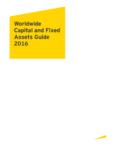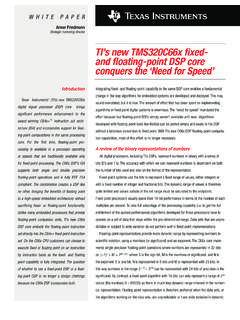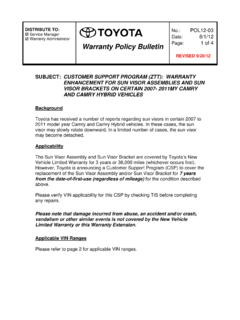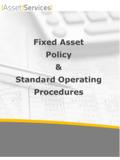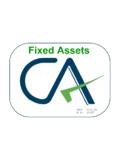Transcription of Depreciation of fixed assets - EY
1 Depreciation of fixed assets What the Companies Act 2013 states EY insights Amendments in Schedule II to the 2013 Act Minimum vs. indicative rates In Schedule II originally notified, all companies were divided into three classes. Class I basically included companies which may eventually apply Ind-AS. These companies were permitted to adopta useful life or residual value, other than those prescribed under the schedule, for their assets , provided they disclose justification for the same. Class II covered companies or assets where useful lives or residual value are prescribed by a regulatory authority constituted under an act of the Parliament or by the Central Government.
2 These companies will use Depreciation rates/useful lives and residual values prescribed by the relevant authority. Class III covered all other companies. For these companies, the useful life of an asset will not be longer than the useful life and the residual value will not be higher than that prescribed in Schedule II. Pursuant to a recent amendment to Schedule II, distinction between class (i) and class (iii) has been removed. Rather, the provision now reads as under: (i) The useful life of an asset shall not be longer than the useful life specified in Part C and the residual value of an asset shall not be more than five per cent of the original cost of the asset: Provided that where a company uses a useful life or residual value of the asset which is different from the above limits, justification for the difference shall be disclosed in its financial statement.
3 From the use of word different , it seems clear that both higher and lower useful life and residual value are allowed. However, a company needs to disclose justification for using higher/lower life and/or residual value. Such disclosure will form part of the financial statements. Proviso in the latest amendment to Schedule II states that if a company uses a useful life or residual value of the asset which is different from limit given in the Schedule II, justification for the difference is disclosed in its financial statements. How is this proviso applied if notified accounting standards, particularly, AS 6 is also to be complied with? AS 6 states that Depreciation rates prescribed under the statute are minimum.
4 If management s estimate of the useful life of an asset is shorter than that envisaged under the statute, Depreciation is computed by applying the higher rate. The interaction of the above proviso and AS 6 is explained with simple examples: The management has estimated the useful life of an asset to be 10 years. The life envisaged under the Schedule IIis 12 years. In this case, AS 6 requires the company to depreciate the asset using 10 year life only. In addition, Schedule II requires disclosure of justification for using the lower life. The company cannot use 12 year life for Depreciation . The management has estimated the useful life of an asset to be 12 years.
5 The life envisaged under the Schedule IIis 10 years. In this case, the company has an option to depreciate the asset using either 10 year life prescribed in the Schedule II or the estimated useful life, 12 years. If the company depreciates the asset over the 12 years, it needs to disclose justification for using the higher life. The company should apply the option selected consistently. Similar position will apply for the residual value. The management has estimated that AS 6 life of an asset and life envisaged in the Schedule II is 10 years. The estimated AS 6 residual value of the asset is nil. The residual value envisaged under the Schedule II is 5%.
6 In this case, AS 6 Depreciation is the minimum threshold. The company cannot use 5% residual value. In addition, Schedule II requires disclosure of justification for using a lower residual value. Alternatively, let us assume that the management has estimated AS 6 residual Continuous process plant Under Schedule II as originally notified, useful life of the CPP, for which there is no special Depreciation rate otherwise prescribed, was 8 years. This was a major concern for certain companies using CPP as they would have been required to write-off their entire plant over 8 years. The amendment to Schedule II has resolved the issue as useful life of the CPPhas now been increased to 25 years.
7 Moreover, the impact of amendment as explained in the preceding paragraph is that a company can depreciate its CPP over a period shorter or longer than 25 years, with proper justification. BOT assets In accordance with amendment made to Schedule XIV to the1956 Act in April 2012, a company was allowed to use revenue based amortization for intangible assets (toll roads) created under BOT, BOOT or any other form of PPP route (collectively, referred to as BOT assets ). Since Schedule II as originally notified did not contain a similar provision, an issue had arisen whether revenue based amortization will be allowed going forward. The recent amendment to Schedule II has addressed this concern.
8 In accordance with the amendment, a company may use revenue based amortization for BOT assets . For amortization of other intangible assets , AS 26 needs to be applied. Double/ triple shift working Under Schedule II, no separate rates/ lives are prescribed for extra shift working. Rather, it states that for the period of time, an asset is used in double shift Depreciation will increase by50% and by 100% in case of triple shift working. Let us assume that a company has purchased one plant and machinery three years prior to the commencement of the2013 Act. Under Schedule XIV, single, double and triple shift Depreciation rates applicable to the asset are , , respectively.
9 Under Schedule II, its life is 15 years. For all three years, the company has used the asset on a triple shift basis and therefore, depreciated of its cost over three years. For simplicity, residual value is ignored. value of the asset to be 10%of the original cost, as against 5% value envisaged in the Schedule II. In this case, the company has an option to depreciate the asset using either 5% residual value prescribed in the Schedule II or the estimated AS 6 residual value, , 10% of the original cost. If the company depreciates the asset using 10% estimated residual value, it needs to disclose justification for using the higher residual value.
10 The company should apply the option selected consistently. Whether the amendment regarding BOT assets allows revenue based amortization only for toll roads? Or can a company apply revenue based amortization to other type of intangible assets created under the BOT model? The amendment in Schedule II reads as follows For intangible assets , the provisions of the accounting standards applicable for the time being in force shall apply except in case of intangible assets (Toll roads) created under BOT, BOOT or any other form of public private partnership route in case of road projects. The amendment clearly suggests that revenue based amortization applies to toll roads.










